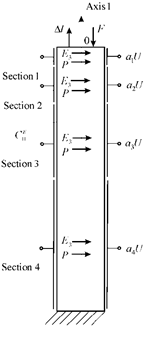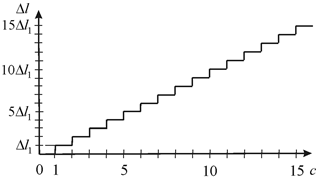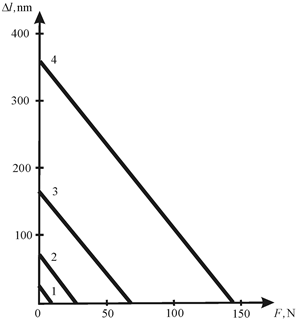The digital-to-analog converter (DAC) electro elastic engine on piezoelectric or electrostriction effect is used for nanomedicine and nanotechnology,1−10 adaptive optics, interferometers, nanomanipulators, nanopumps, microsurgery, scanning microscopy and nanophysics.8−29
The problem of use the coded control and the DAC electro elastic engine is promising for nanomedicine. The DAC electro elastic engine can be applied to increase the range of displacement from nano- to microdisplacement in control systems.1−10
The DAC electro elastic engine consists of N sections with n electro elastic layers. The electro elastic layers in the DAC electro elastic engine are connected electrically in parallel and mechanically in series for the section. In this work, the mechanical and regulation characteristics of the DAC electro elastic engine are determined by using method of mathematical physics.
DAC electro elastic engine
The number of the layers in the section of the DAC electro elastic engine is equal to the degree of 2. For the DAC transverse piezo engine for nanomedicine on Figure 1 its equation of the reverse piezo effect1−12 has the form.
here S1, E3, T1, d31,
− the relative deformation on axis 1, the electric field stress on axis 3, the mechanical stress on axis 1, the transverse piezo module and the elastic compliance at
We have the displacement
of the section k with the length
of the DAC transverse piezo engine at
in the form
here
,
− is the thickness of the DAC electro elastic engine.
Therefore, the displacement of the DAC transverse piezo engine on Figure 1 at
is found in the form

Figure 1 DAC transverse piezo engine.
here l,
− the length of the DAC transverse piezo engine and the binary code of the section.
The displacement of the DAC transverse piezo engine has the form
Therefore, the displacement is written in the form
here
− the rigidity of the DAC transverse piezo engine. In this equation we have the maximum displacement and maximum force of the DAC transverse piezo engine in the form
at
at
In general for the digital-to-analog converter (DAC) electro elastic engine its equation of the reverse piezo effect1−19 has the form:
here
,
,
,
and
− the relative deformation on axis i, the electric field stress on axis m, the mechanical stress on axis j, the piezo module and the elastic compliance at
.
Characteristics DAC electro elastic engine
In general the mechanical characteristic of the DAC electro elastic engine is written in the form
here
and
are written in the form
at
at
,
,
here
,
, l − the rigidity of the DAC electro elastic engine, the displacement of first section, the length of the DAC electro elastic engine.
The static characteristics of the DAC electro elastic engine at elastic load has the form
In general the adjustment characteristic of the DAC electro elastic engine on Figure 2 is found in the form
,
,

Figure 2 Adjustment characteristic of DAC electro elastic engine.
here
− the decimal code.
Therefore, for the DAC piezo engine from PZT ceramic at
= 0.2 nm/V,
= 0.4 nm/V and
= 0.5 nm/V,
= 1,
= 0, and U =20 V we have on Figure 2, therefore, the parameters for the DAC transverse, longitudinal and shift piezo engines
= 4 nm,
= 8 nm and
= 10 nm with error 10%.
Let us consider the mechanical characteristic of the DAC longitudinal piezo engine.
Its maximum parameters of the mechanical characteristic of the DAC longitudinal piezo engine on Figure 3 are determined in the form
here
is the rigidity of the rigidity of the DAC longitudinal piezo engine.
For the DAC longitudinal piezo engine from PZT ceramic at
= 0.4 nm/V,
= 1,
= 4×108 N/m, and U = 60 V for 1)
= 1,
= 0,
= 0,
= 0; 2)
= 1,
= 1,
= 0,
= 0; 3)
= 1,
= 1,
=1,
= 0; 4)
= 1, = 1, =1, = 1 the parameters of the DAC longitudinal piezo engine on Figure 3 are determined in the form 1)
= 24 nm,
= 9.6 N; 2)
= 72 nm,
= 28.8 N; 3)
= 168 nm,
= 67.2 N; 4)
= 360 nm,
= 144 N with error 10%.

Figure 3 Mechanical characteristic of DAC longitudinal piezo engine.
Thus, the mechanical and regulation characteristics of the DAC electro elastic engine are found.


